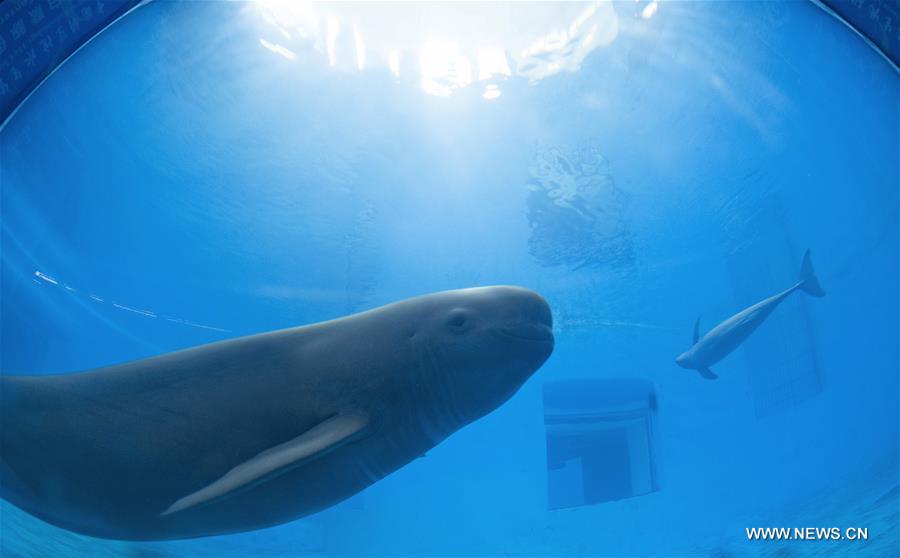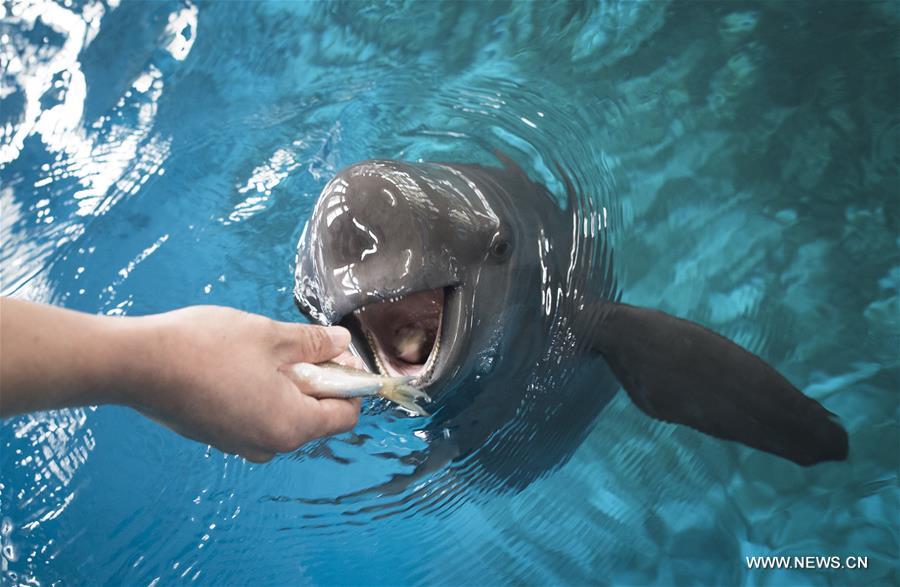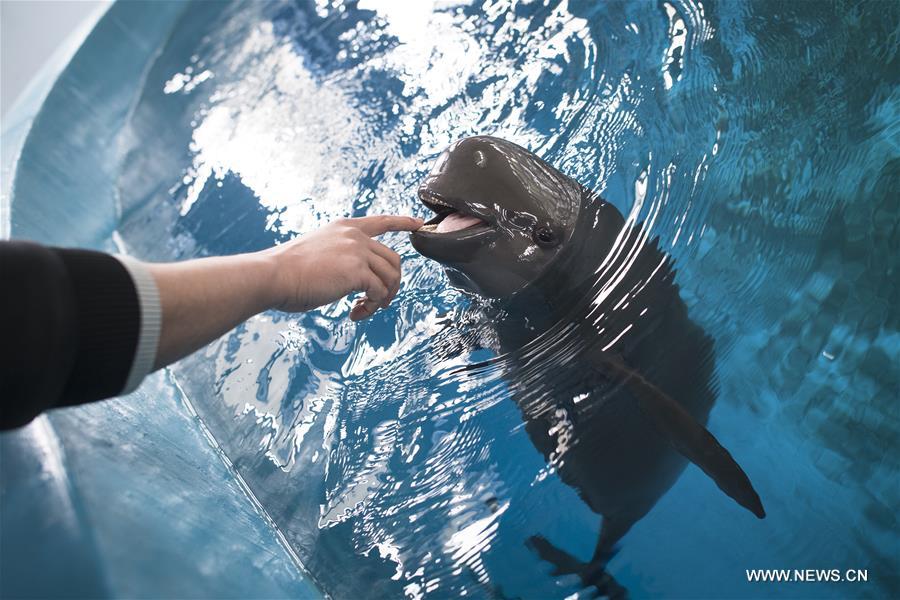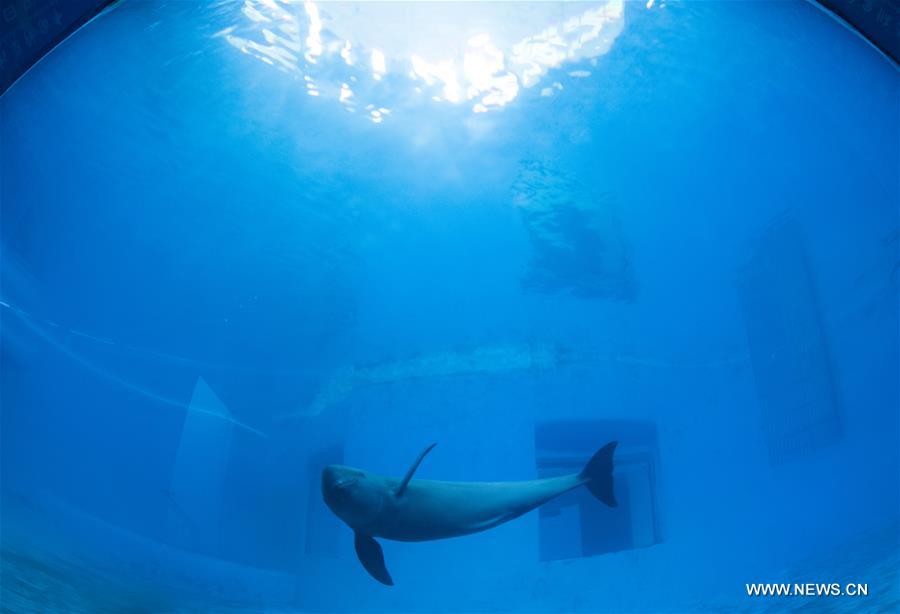

A keeper gives medical care training to Yangtze finless porpoises at the Yangtze River Dolphin aquarium in the Institute of Hydrobiology of the Chinese Academy of Sciences in Wuhan, capital of central China's Hubei Province, on Nov. 10, 2018. With a slightly curved mouth, the Yangtze finless porpoise is often called the "smiling angel" of the Yangtze by Chinese. However, the population has been rapidly decreasing over the last three decades due to environmental deterioration. The species now teeters on the brink of extinction with a population of around 1,000 in the main waterway of the Yangtze, according to research conducted in 2012. (Xinhua/Xiao Yijiu)

Yangtze finless porpoises swim at the Yangtze River Dolphin aquarium in the Institute of Hydrobiology of the Chinese Academy of Sciences in Wuhan, capital of central China's Hubei Province, on Nov. 10, 2018. With a slightly curved mouth, the Yangtze finless porpoise is often called the "smiling angel" of the Yangtze by Chinese. However, the population has been rapidly decreasing over the last three decades due to environmental deterioration. The species now teeters on the brink of extinction with a population of around 1,000 in the main waterway of the Yangtze, according to research conducted in 2012. (Xinhua/Xiao Yijiu)

A Yangtze finless porpoise swims at the Yangtze River Dolphin aquarium in the Institute of Hydrobiology of the Chinese Academy of Sciences in Wuhan, capital of central China's Hubei Province, on Nov. 10, 2018. With a slightly curved mouth, the Yangtze finless porpoise is often called the "smiling angel" of the Yangtze by Chinese. However, the population has been rapidly decreasing over the last three decades due to environmental deterioration. The species now teeters on the brink of extinction with a population of around 1,000 in the main waterway of the Yangtze, according to research conducted in 2012. (Xinhua/Xiao Yijiu)

A keeper feeds a Yangtze finless porpoise at the Yangtze River Dolphin aquarium in the Institute of Hydrobiology of the Chinese Academy of Sciences in Wuhan, capital of central China's Hubei Province, on Nov. 10, 2018. With a slightly curved mouth, the Yangtze finless porpoise is often called the "smiling angel" of the Yangtze by Chinese. However, the population has been rapidly decreasing over the last three decades due to environmental deterioration. The species now teeters on the brink of extinction with a population of around 1,000 in the main waterway of the Yangtze, according to research conducted in 2012. (Xinhua/Xiao Yijiu)

A Yangtze finless porpoise swims at the Yangtze River Dolphin aquarium in the Institute of Hydrobiology of the Chinese Academy of Sciences in Wuhan, capital of central China's Hubei Province, on Nov. 10, 2018. With a slightly curved mouth, the Yangtze finless porpoise is often called the "smiling angel" of the Yangtze by Chinese. However, the population has been rapidly decreasing over the last three decades due to environmental deterioration. The species now teeters on the brink of extinction with a population of around 1,000 in the main waterway of the Yangtze, according to research conducted in 2012. (Xinhua/Xiao Yijiu)

A keeper gives medical care training to Yangtze finless porpoises at the Yangtze River Dolphin aquarium of the Institute of Hydrobiology of the Chinese Academy of Sciences in Wuhan, capital of central China's Hubei Province, on Nov. 10, 2018. With a slightly curved mouth, the Yangtze finless porpoise is often called the "smiling angel" of the Yangtze by Chinese. However, the population has been rapidly decreasing over the last three decades due to environmental deterioration. The species now teeters on the brink of extinction with a population of around 1,000 in the main waterway of the Yangtze, according to research conducted in 2012. (Xinhua/Xiao Yijiu)

A keeper gives medical care training to Yangtze finless porpoises at the Yangtze River Dolphin aquarium of the Institute of Hydrobiology of the Chinese Academy of Sciences in Wuhan, capital of central China's Hubei Province, on Nov. 10, 2018. With a slightly curved mouth, the Yangtze finless porpoise is often called the "smiling angel" of the Yangtze by Chinese. However, the population has been rapidly decreasing over the last three decades due to environmental deterioration. The species now teeters on the brink of extinction with a population of around 1,000 in the main waterway of the Yangtze, according to research conducted in 2012. (Xinhua/Xiao Yijiu)

Yangtze finless porpoises swim at the Yangtze River Dolphin aquarium in the Institute of Hydrobiology of the Chinese Academy of Sciences in Wuhan, capital of central China's Hubei Province, on Nov. 10, 2018. With a slightly curved mouth, the Yangtze finless porpoise is often called the "smiling angel" of the Yangtze by Chinese. However, the population has been rapidly decreasing over the last three decades due to environmental deterioration. The species now teeters on the brink of extinction with a population of around 1,000 in the main waterway of the Yangtze, according to research conducted in 2012. (Xinhua/Xiao Yijiu)

A keeper gives medical care training to a Yangtze finless porpoise at the Yangtze River Dolphin aquarium in the Institute of Hydrobiology of the Chinese Academy of Sciences in Wuhan, capital of central China's Hubei Province, on Nov. 10, 2018. With a slightly curved mouth, the Yangtze finless porpoise is often called the "smiling angel" of the Yangtze by Chinese. However, the population has been rapidly decreasing over the last three decades due to environmental deterioration. The species now teeters on the brink of extinction with a population of around 1,000 in the main waterway of the Yangtze, according to research conducted in 2012. (Xinhua/Xiao Yijiu)

A keeper gives medical care training to a Yangtze finless porpoise at the Yangtze River Dolphin aquarium in the Institute of Hydrobiology of the Chinese Academy of Sciences in Wuhan, capital of central China's Hubei Province, on Nov. 10, 2018. With a slightly curved mouth, the Yangtze finless porpoise is often called the "smiling angel" of the Yangtze by Chinese. However, the population has been rapidly decreasing over the last three decades due to environmental deterioration. The species now teeters on the brink of extinction with a population of around 1,000 in the main waterway of the Yangtze, according to research conducted in 2012. (Xinhua/Xiao Yijiu)

A Yangtze finless porpoise swims at the Yangtze River Dolphin aquarium in the Institute of Hydrobiology of the Chinese Academy of Sciences in Wuhan, capital of central China's Hubei Province, on Nov. 10, 2018. With a slightly curved mouth, the Yangtze finless porpoise is often called the "smiling angel" of the Yangtze by Chinese. However, the population has been rapidly decreasing over the last three decades due to environmental deterioration. The species now teeters on the brink of extinction with a population of around 1,000 in the main waterway of the Yangtze, according to research conducted in 2012. (Xinhua/Xiao Yijiu)

86-10-68597521 (day)
86-10-68597289 (night)

52 Sanlihe Rd., Xicheng District,
Beijing, China (100864)

